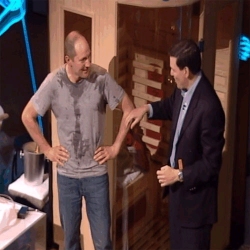The Effect of Extreme Heat on the Body in an Infrared Sauna
This article will describe what happens to the body’s temperature when it is exposed to the extreme heat of a sauna.
The hottest place on the earth surface is Al'Aziziyah in the Libyan Desert with a record temperature of 58°C/136.4°F in 1922, with Death Valley coming in a close second, at 134° F/ 56.6°C on July 10, 1913. The body temperature of the human body is approximately 37°C. If the body’s temperature rose to 42°C, it would die, showing how finely tuned the body is made.
 Before Entering the Infrared Sauna Before Entering the Infrared SaunaOn 26th December 2007 a television show on Channel 5 called 'Grilled and Chilled', produced by The Royal Institution Christmas Lectures, conducted an experiment on what effect extreme temperatures have on the body. To test this, they needed an infrared sauna and as a result, they approached Di Vapor to request the use of one of its saunas. Di Vapor was happy to help the Institution by donating one of its infrared saunas, especially as the show was in the interest of science and education. During the show, the infrared sauna was pre-heated to 58°C. The person who volunteered for this experiment swallowed a white pill called a radio thermometer, which transmits the temperature inside their stomach to the outside world. The signal is picked up by a receiver and is then fed through to the computer, which shows the current internal core temperature of the volunteers’ body. An infrared sauna was used instead of a traditional sauna in this experiment as the infrared sauna simulates the heat of the sun much more accurately than the traditional stove sauna. Infrared waves are the reason why the body feels deep penetrating warmth in the sun, as the waves penetrate further than the surface of the skin. The initial starting temperature of the volunteers’ body was 37.34°C. The volunteer then stepped, fully clothed, into the sauna for 10 minutes.
In the body, heat is lost through conduction, convection through air movement and by radiating away the heat. However, this heat loss is only possible if the temperature of the air is cooler than the body temperature of the person. On the other hand, if the air temperature and anything which the body is touching is hotter than the temperature of the body, then conduction, convection through air movement and radiation will not take the heat away from you, in fact it does the opposite: it will actually deliverer the heat to the body, causing it to heat up. Therefore, when one is inside a sauna which is hotter than 37°C, the body cannot cool itself down in those different ways.
If you blow on the back of your hand, you will feel it will be cool, as the heat is taken away through convection. Now, if you wet the back of your hand, or lick it, and then blow on it, you will feel it is much cooler than when you just blew on it. This is because the water on the skin is evaporating, and evaporating water takes away a lot of heat from the body. The body burns 1 calorie for every 1.5ml of water you evaporate. The sweat glands are the body's natural way of keeping itself cool. They create salty water which lies on the skin like a thin sheet and evaporates to keep you cool. There are approximately 2.6 million of these tiny sweat glands on your body; that equates to about 120 for every square centimetre of skin. When the body sweats, for example, in a sauna, a hot climate, when exercising or in a steam room, the tiny sweat glands will release this watery fluid. This watery fluid contains salt, urea and traces of toxins.
On a very hot day, the body can easily lose 1.5 to 2 litres of water per hour. The body's gut can only absorb 1.5 litres of water per hour; therefore it's very difficult to keep the body hydrated when one is exercising on a very hot day, even impossible to stay sufficiently hydrated. This illustrates the importance of drinking sufficient water while taking a sauna session.  After Exiting the Infrared Sauna After Exiting the Infrared SaunaAfter the volunteer came out of the sauna, after being in the 58 degrees heat for 10 minutes, his body temperature only rose 0.35 degrees from 37.34°C to 37.69°C. From these results, we can see that being in a hot sauna does increase the body’s temperature slightly; however, the increase is minor. This experiment definitely does show how incredible the body’s ability is to regulate its temperature, to keep it at a constant 37°C. Enjoy a sauna session and enjoy the health benefits associated with them, but remain hydrated for a safe and enjoyable experience.
Note: Di Vapor is not responsible for the views, opinions or advice represented in the articles on this site. You are advised to seek medical advice before following any such information. Copyright © July 2008 Di Vapor.
| 
